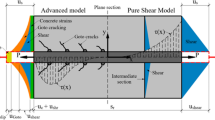Abstract
Crack width calculation is one of the serviceability requirements in the structural concrete elements. Estimation of maximum crack widths under service loading, when response remains in linear range, is well studied in the literature. However, when an RC building is subjected to extreme loading such as an earthquake, peak response of RC members is usually in the post-yield region. The applicability of available crack width formulation in post-yield response range has not been studied in the literature. Additionally, the relationship between maximum crack width that occurs at peak response, and residual crack width that occurs at the end of loading, is not available in published the literature. Such relationship is useful to trace the peak loading experienced by the member from its condition, observed at the zero force condition. In the present study, the available crack width formulae are reviewed thoroughly and validated in pre- and post-yield response ranges by reproducing observed experimental responses. The simulated experimental responses are also used to develop a relationship between residual and maximum crack widths. The effect of cyclic loading on the residual crack width is also presented in the present paper.
Access this chapter
Tax calculation will be finalised at checkout
Purchases are for personal use only
Similar content being viewed by others
References
Borosnyoi A, Balazs GL (2005) Models for flexural cracking in concrete: the state of the art. Struct Concr 6(2):53–62
Bazant ZP, Oh BH (1983) Spacing of cracks in reinforced concrete. J Struct Eng ASCE 109(9):2066–2085
Oh BH, Kang YJ (1987) New formulas for maximum crack width and crack spacing in reinforced concrete flexural members. ACI Struct J 84(2):103–112
Balazs GL (1993) Cracking analysis based on slip and bond stresses. ACI Mater J 90(4):340–348
Oh BH, Kim SH (2007) Advanced crack width analysis of reinforced concrete beams under repeated loads. J Struct Eng ASCE 133(4):411–420
Gergely P, Lutz LA (1968) Maximum crack width in reinforced concrete flexural members. ACI Spec Publ 20
Frosch RJ (1999) Another look at cracking and crack control in reinforced concrete. ACI Struct J 96(3):437–442
ACI-318 (2008) Building code requirements for structural concrete and commentary. ACI Committee
Eurocode-2 (1991) Design of concrete structures: {Part 1}: General rules and rules for buildings. European Committee for Standardization
Allam SM, Shoukry MS, Rashad GE, Hassan AS (2012) Crack width evaluation for flexural RC members. J Alex Eng 51(3):211–220
Sezen H, Moehle JP (2003) Bond-slip behavior of reinforced concrete members. In: Proceedings of FIB symposium on concrete structures in seismic regions
Chen L, Lu X, Jiang H, Zheng J (2009) Experimental investigation of damage behavior of RC frame members including non-seismically designed columns. Earthq Eng Eng Vib 8(2):301–311
Dazio A, Beyer K, Bachmann H (2009) Quasi-static cyclic tests and plastic hinge analysis of RC structural walls. Eng Struct 31(7):1556–1571
Verderame GM, Fabbrocino G, Manfredi G (2008) Seismic response of RC columns with smooth reinforcement. Part I: Monotonic tests. Eng Struct 30(9):2277–2288
Verderame GM, Fabbrocino G, Manfredi G (2008) Seismic response of RC columns with smooth reinforcement. Part II: Cyclic tests. Eng Struct 30(9):2277–2288
Krolicki J, Maffei J, Calvi GM (2011) Shear strength of reinforced concrete walls subjected to cyclic loading. J Earthq Eng 15(S1):30–71
Oh BH, Kim SH (2007) Realistic models for local bond stress-slip of reinforced concrete under repeated loading. J Struct Eng ASCE 133(2):216–224
Author information
Authors and Affiliations
Corresponding author
Editor information
Editors and Affiliations
Rights and permissions
Copyright information
© 2019 Springer Nature Singapore Pte Ltd.
About this paper
Cite this paper
Shiradhonkar, S., Sinha, R. (2019). Estimation of Residual Crack Widths in Post-Yield Response Range. In: Rao, A., Ramanjaneyulu, K. (eds) Recent Advances in Structural Engineering, Volume 2. Lecture Notes in Civil Engineering , vol 12. Springer, Singapore. https://doi.org/10.1007/978-981-13-0365-4_51
Download citation
DOI: https://doi.org/10.1007/978-981-13-0365-4_51
Published:
Publisher Name: Springer, Singapore
Print ISBN: 978-981-13-0364-7
Online ISBN: 978-981-13-0365-4
eBook Packages: EngineeringEngineering (R0)




